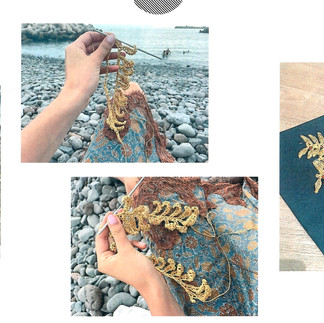CLARA BENADON : Eco-Artist Extraordinaire at Art Techno Lab Collaboration in Madeira
- ARTE.M

- Mar 11, 2024
- 2 min read
Updated: Apr 1, 2024
One of the standout instances of collaboration within the Georgian delegations from ART TECHNO LAB was exemplified by a partnership with an environmental artist and marine biologist Clara Benadon.
It is the long-awaited exhibition that is being prepared for its opening on April 12 at the Caravel Art Centre in Funchal. So...
Clara Benadon, a Thomas J. Watson fellow, is jet-setting across the globe on a mission to unravel the fascinating connections between climate change, wool agriculture, and the art of textiles.
Currently stationed in picturesque Funchal, Madeira, she's diving deep into her internship at the Marine and Environmental Sciences Centre (MARE) while also channeling her artistic flair as a resident artist at ARTE.M artistic association and Art Center Caravel.
Her goal? To weave together the threads of local environmental research, courtesy of MARE, into stunning, eco-conscious tapestries.

As an experimental initiative, the Georgian delegation developed a mock website that would share environmental art such as Clara’s. They interviewed her, took promotional photos, and engaged in cross-promotion across various media platforms, including Clara's own social media channels, the ARTE.M association, and the Art Center Caravel. The results of Clara’s artistic endeavors remain to be seen, and we eagerly anticipate seeing the final results at the grand opening of her exhibition on April 12th, 2024.
Our team: Eco-Artist Clara Benadon
Promo and marketing: Gogaladze Luka, Elene Tabatadze
Producer: Lela Gharishvili
For one of her tapestries, Clara is crocheting sargassum, a marine seaweed that floats and drifts in large rafts. Its tangled vegetation provides habitat for dozens of species. Some species rely on floating sargassum only as vulnerable juveniles, while others are specially adapted to sargassum and are found living within it. Originally native to the tropical Atlantic, human impacts have led to an increase in its quantity and wider geographic range. Agricultural runoff and development have boosted the supply of nutrients necessary for sargassum growth, while climate change has disrupted wind patterns, facilitating its drift to new locations. Large amounts of sargassum are now appearing in Madeira for the first time, blanketing beaches. Local scientists are concerned that this seaweed may introduce non-native (invasive) species with unknown impacts on the marine environment. Clara collaborates with scientists at MARE and the Regional Directorate for the Environment and Climate Action to explore this issue further.
*PS: Web was created as part of an experimental virtual and real art residency ART TECHNO LAB held in Madeira in February 2024 and this is a prototype of a real site. Our task was to learn how to create various digital products related to art, culture and heritage.





























Comments